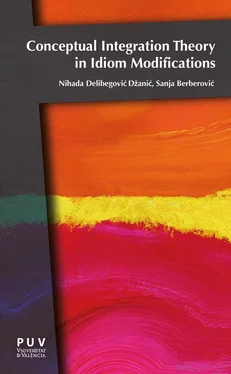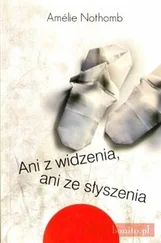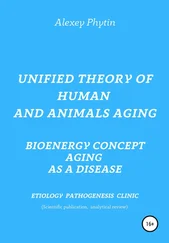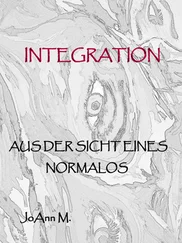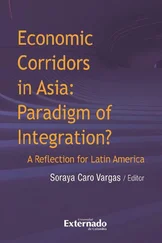Conceptual Integration Theory
in Idiom Modifications
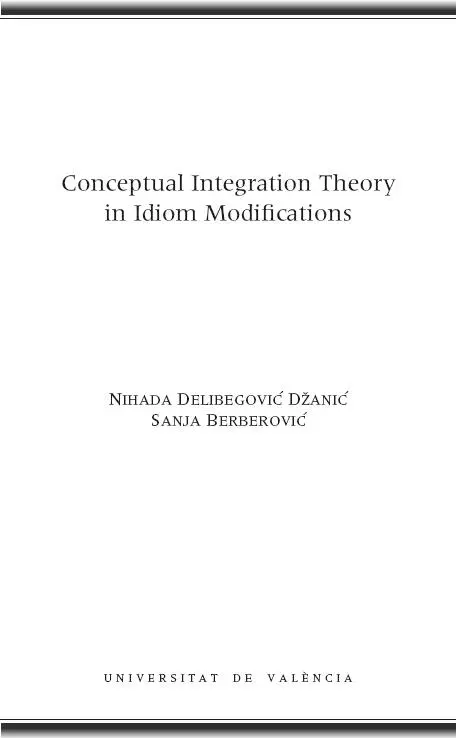
ENGLISH IN THE WORLD SERIES
GENERAL EDITOR
Antonia Sánchez Macarro
Universitat de València, Spain
ADVISORY EDITORIAL BOARD
Professor Enrique Bernárdez
Universidad Complutense de Madrid, Spain
Professor Anne Burns
Macquarie University, Sydney, Australia
Professor Angela Downing
Universidad Complutense de Madrid, Spain
Dr Martin Hewings
University of Birmingham, Great Britain
Professor Ken Hyland
University of East Anglia, Norwich, Great Britain
Professor James Lantolf
Penn State University, Pennsylvania, USA
Professor Michael McCarthy
University of Nottingham, Great Britain
Professor Eija Ventola
University of Helsinki, Findland
© Nihada Delibegović Džanić & Sanja Berberović
© 2019 by the Universitat de València
Design and typeset: Celso Hdez. de la Figuera Cover design by Pere Fuster (Borràs i Talens Assessors SL)
ISBN: 978-84-9134-556-5
CONTENTS
Abbreviations, Symbols and Font Styles Abbreviations, Symbols and Font Styles ACT a cognitive architecture: a theory for simulating and understanding human cognition BNC British National Corpus e.g. for example (Latin exempli gratia ) etc. and other similar things, and the rest; and so on (Latin et cetera) FEI(s) fixed expression(s) ICM(s) idealized cognitive model(s) i.e. that is (Latin id est ) PU(s) phraseological unit(s) * an example which is ungrammatical or unacceptable underline part of an example highlighted for attention bold highlighting in the text italic highlighted PU SMALL CAPS conceptual metaphors and metonymies
Table of Figures
1Introduction
2Phraseology
3On Idioms
3.1. Idioms Defined
3.2. Characteristics of Idioms
3.3. Classification of Idioms
3.4. The Cognitive Linguistic View of Idioms
3.4.1. Idioms Based on Metaphor
3.4.2. Idioms Based on Conventional Knowledge
3.4.3. Idioms Based on Metonymy
3.5. Modifications of Idiomatic Expressions
4On Conceptual Integration Theory
4.1. An Insight into Conceptual Integration Theory
4.2. Vital Relations
4.3. Optimality Principles
4.4. Some examples
4.5. Compression and Decompression
4.5.1. Simplex Networks
4.5.2. Mirror Networks
4.5.3. Single-Scope Networks
4.5.4. Double-Scope Networks
4.6. Criticism of the Conceptual Integration Theory
4.6.1. Idiom modifications and the blending theory
5Modified idiomatic expressions under conceptual integration magnifying glass
5.1. Structural modification
5.1.1. Formal Blending
5.1.2. Clipping
5.1.3. Permutation
5.1.4. Reconstruction
5.2. Lexical modification
5.2.1. Addition
5.2.2. Substitution
5.3. Mixed types
5.3.1. Permutation and Clipping
5.3.2. Addition and Clipping
5.3.3. Substitution and Clipping
5.3.4. Substitution and Addition
6Concluding remarks
7References
Abbreviations, Symbols and Font Styles
| ACT |
a cognitive architecture: a theory for simulating and understanding human cognition |
| BNC |
British National Corpus |
| e.g. |
for example (Latin exempli gratia ) |
| etc. |
and other similar things, and the rest; and so on (Latin et cetera) |
| FEI(s) |
fixed expression(s) |
| ICM(s) |
idealized cognitive model(s) |
| i.e. |
that is (Latin id est ) |
| PU(s) |
phraseological unit(s) |
| * |
an example which is ungrammatical or unacceptable |
| underline |
part of an example highlighted for attention |
| bold |
highlighting in the text |
| italic |
highlighted PU |
| SMALL CAPS |
conceptual metaphors and metonymies |
Table of Figures
Figure 1. The phraseology system of Modern English (Gläser, 1998: 128)
Figure 2. Input mental spaces (Fauconnier and Turner, 2002)
Figure 3. Cross-space mapping (Fauconnier and Turner, 2002)
Figure 4. Generic mental space (Fauconnier and Turner, 2002)
Figure 5. Blended space (Fauconnier and Turner, 2002)
Figure 6. (Fauconnier and Turner, 2002)
Figure 7. (Brandt and Brandt, 2005 b )
Figure 8. Conceptual integration network for I’m thirty and I have both feet in the clouds
Figure 9. Conceptual integration network for ARAMARK has taken a lot off our plate
Figure 10. Conceptual integration network for Don’t know about a wild goose chase, this is a lame duck chase
Figure 11. Conceptual integration network for Bush tried to sweep the skeleton under the rug
Figure 12. Conceptual integration network for Don’t chew more than you can bite
Figure 13. Conceptual integration network for If you cannot join them, beat them
Figure 14. Conceptual integration network for The golden goose became a turkey
Figure 15. Conceptual integration network for There is a lot more to Africa than the bits that make the headlines
Figure 16. Conceptual integration network for Deep pockets run shallow
Figure 17. Conceptual integration network for There is something about Bush’s cupboard that makes the skeleton terribly restless
Figure 18. Conceptual integration network for We didn’t just jump on the infrastructure bandwagon. We built it
Figure 19. Conceptual integration network for When the going gets tough, the women can get as tough as the men
Figure 20. Conceptual integration network for Are you telling me that there is a politician in this country who does not have a blue dress in his closet?
Figure 21. Conceptual integration network for You can’t teach a gay dog a straight trick
Figure 22. Conceptual integration network for It’s time to dig up the hatchet
Figure 23. Conceptual integration network for We could soon be giving the Americans a waddle for their money
Figure 24. Conceptual integration network for Hustle breeds hostility
Figure 25. Conceptual integration network for Thus the genius of songwriters has been brought to bear on writing a gospel more suited to our age when a baby is born with a plastic spoon in its mouth
Figure 26. Conceptual integration network for Mad dogs and mergers
Figure 27. Conceptual integration network for A handkerchief in time saves nine and helps to keep the nation fit
1
Introduction
In this book we will try to throw more light on mechanisms of idiom modification. Previous studies of idiom modification have not suggested a consistent argument why only certain types of modifications are acceptable for a given idiom whilst others are not. Actually, previous studies have not provided a coherent answer to the question to what extent an idiom can be modified to retain the link with the original phraseological unit, so that recipients can recognize it as a modification of an established original. The main aim of this study is to analyse the extent to which vital relations and optimality principles at work in conceptual integration can account for mechanisms of idiom modification. We also aim to present an overview and analysis of previous studies of idioms and idiom modifications and give an overview and analysis of cognitive linguistic theories that can account for the mechanisms of idiom modifications.
Читать дальше
